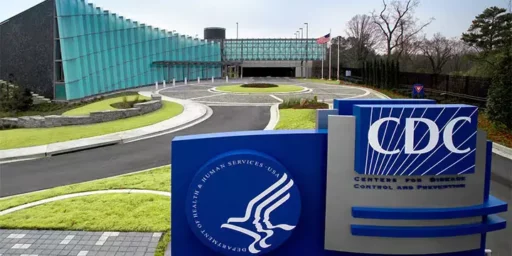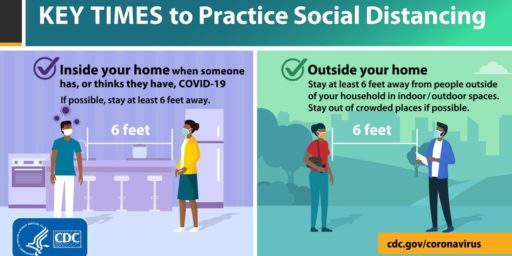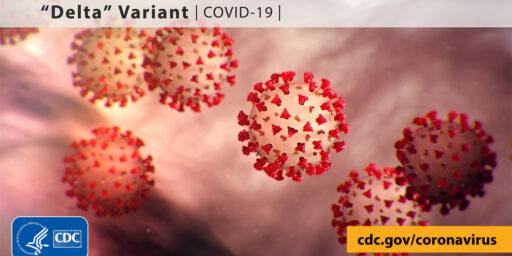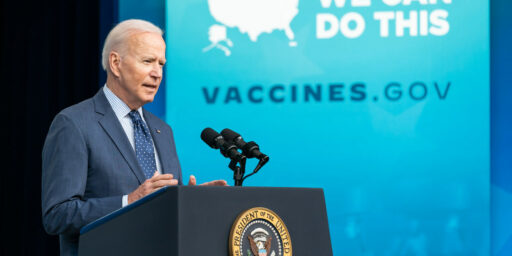COVID’s Symptoms Have Evolved
The combination of new variants and increased immunity has changed how the disease presents.

Fortune (“COVID symptoms aren’t what they used to be. Here’s how they’ve changed over time, and what they look like now“):
Losing the ability to taste and smell is no longer common among COVID patients, according to a new study that highlights the virus’s ever-changing nature.
Sore throat, runny nose, nasal congestion, persistent cough, and headache are now the most common symptoms of COVID among the fully vaccinated, the Zoe Health Study found. The study, run by scientists at Harvard and Stanford universities, is based on data submitted by U.S. and U.K. participants logging in their symptoms via an app for research purposes.
So, essentially, COVID now presents as a common cold or seasonal allergies?
The new symptom list stands in contrast with classic, more severe COVID-19 symptoms such as persistent cough, loss of smell, fever, and shortness of breath that were common at the pandemic’s outset. Such symptoms now rank as No. 5, 6, 8, and 29, respectively, according to the study.
Symptoms that are common presently among those who had one vaccine dose include headache, runny nose, sore throat, sneezing, and persistent cough. Symptoms among the unvaccinated are very similar but include fever instead of sneezing, and a sore throat more often than a runny nose.
Interestingly, those who have been vaccinated and have COVID are more likely to report sneezing than those who have not been vaccinated and have COVID.
“If you’ve been vaccinated and start sneezing a lot without an explanation, you should get a COVID test, especially if you are living or working around people who are at greater risk from the disease,” the authors wrote.
It is what it is, of course, but I suspect very unlikely to be heeded. People now treat COVID is akin to the seasonal flu and are unlikely to rush out to get tested for routine symptoms.
While COVID patients requiring hospitalization during the Delta wave in late 2021 tended to have pneumonia-like symptoms, COVID patients during the Omicron era more often have symptoms similar to the common cold, according to a June article in Infectious Disease Reports. The four commonly circulating human coronaviruses aside from COVID usually present as common colds.
The shift likely occurred because the Delta variant tended to thrive in the lower respiratory system of those infected, while the Omicron variant, especially more recent strains, tends to thrive in the upper respiratory system. That’s subject to change, however, as the virus evolves.
It’s impossible to say whether Omicron is less severe than Delta, experts say, because the population has continued to build its immunity as the virus evolves. When people are infected or vaccinated, it boosts their immune systems—and while antibody immunity lasts only a few months, T-cell immunity, which can make infections milder, lasts for much longer.
It’s possible that COVID is becoming more akin to the seasonal flu, experts say, with milder, cold-like symptoms and cases that are more common during winter. But it’s too early to tell, they caution, adding that the virus could change course at any point.
While everyone in my household has seemingly avoided contracting COVID, I suspect it’s only a matter of time. It’s running rampant through my workplace; I’d estimate that half of my colleagues have it or have had it. At least once a week, someone reports that they’ve tested positive.






My sister-in-law experienced loss of taste and smell in her bout with Covid in the summer. A friend of mine thinks he had a reduced sense of smell when he had it a few weeks ago, though he wasn’t so sure.
This cracked me up for some reason. What, exactly is “without an explanation”? It’s autumn (fall allergies) and I’ve been busy so haven’t dusted in a few weeks. If I start sneezing, do I assume the obvious (fall allergies/dust), or is this “without explanation”?
@Jen: Yeah, I have seasonal allergies and I’ve had sudden sneezing fits for years.
@Kylopod: My paternal grandfather would have sneezing fits for no apparent reason — knock off 20-30 big sneezes in quick succession. My father would have sneezing fits for no apparent reason — 20-30 big sneezes in quick succession. I have had sneezing fits for no apparent reason for more than 50 years — 20-30 sneezes in quick succession. The first time my wife-to-be saw one, she thought I was dying. My son seems to have avoided the curse.
@Michael Cain: I typically sneeze 1-2 times when my nose gets irritated. A week or two ago, I was driving and had a series of sneezes–maybe 8 or 9?–in a row that was far above my typical. It was odd enough that I remember thinking a few times “what the heck was that?”
I cannot imagine it was covid. If it was, that’s the entirety of my symptoms.
That part hasn’t changed from the days early on when I was required to have my temperature checked upon entering the school building/medical clinic. Everybody had to but it was especially important in my case because I have COPD, asthma, and seasonal allergies (one of the lucky ones with 4-season seasonal allergies), I was always likely to be an “asymptomatic” carrier. Of the seven indicators, high fever and loss of taste/smell were the only markers I would have presented.
“While everyone in my household has seemingly avoided contracting COVID, I suspect it’s only a matter of time. It’s running rampant through my workplace; I’d estimate that half of my colleagues have it or have had it. At least once a week, someone reports that they’ve tested positive.”
It’s too bad that wearing a mask is performative virtue signaling and completely unnecessary and useless now. It sounds like it might be a good idea otherwise at places like your workplace. 🙁
@Just nutha ignint cracker:
It bears repeating.
BTW, when declining to attend gatherings, replies have gone in this progression:
Mid 2021: Everyone coming is fully vaccinated.
Late 2021 to Summer 2022: We’re all going to get it anyway.
Summer 2022 to the present: It’s not really circulating anymore, and you won’t be able to avoid it anyway.
I’m not a good fatalist, but I remain uninfected (that I know of; I concede I might have had a fully asymptomatic case because there’s no way to know).
Ok. It seems to be circulating less than it used to. And I’ve high confidence in long term vaccine protection. Just the same, I keep trying to have as little contact as possible, and wear a mask at all times outside my apartment (and sometimes outside my room).
I might risk an outing to the movies, as soon as there’s something worth watching that won’t be on streaming for months* (Black Adam does not qualify). Even then, I’d probably go to an early showing at a premium theater (fewer people at such times and places), and wear a mask.
*At this point, nothing might make the cut. I like seeing movies in a bigger screen with better sound, but I dislike paying extra for something I can get for free by waiting.
@Kathy: I do like the effect of the big screen but can’t justify the expense–the last time I checked Regal Cinemas here was charging ~$13–and the movies I HAVE seen have been mediocre. (And I’ll see and raise you on Black Adam not being it.)
@Just nutha ignint cracker:
Last movie I saw in theaters was The Rise of Skywalker in 2019. Prices have gone up since. I checked and found my go to premium theater charging around $8.50. I assume my backup premium theater charges around the same (that one’s even closer to my apartment, but the other one is nicer and has better service).
This includes value added tax (16%). Parking is extra.
@Kathy: Rise of Skywalker was $12.50 where I live IIRC.
@Kathy: Just to scratch an itch, I looked up the price for Black Adam: Reserved seating–$15.10, RPX (whatever that means) $17.20
This is ordering on line through Fandango, so there’s probably a convenience fee or upcharge of some sort.
@Just nutha ignint cracker:
I wish people would stop thinking about masks in a binary it-blocks-everything-or-it’s-useless way. With most infections the viral load one gets is a very important factor.
Key to our immune response is time. Takes more time for the exponential progression of an infection to get rolling when the initial dose is just a few bugs than it does with it being several thousand. The first guy who died from COVID was the doc in China who was working with it and patients, he was a fairly young guy in good health and was dead in a week. In all likelihood died because he got a massive initial dose, just for one example.
@Just nutha ignint cracker:
There are ticket brokers here, too. But for the movies I get them direct from the chain’s website. As far as I can tell, there’s no commission or added fees.